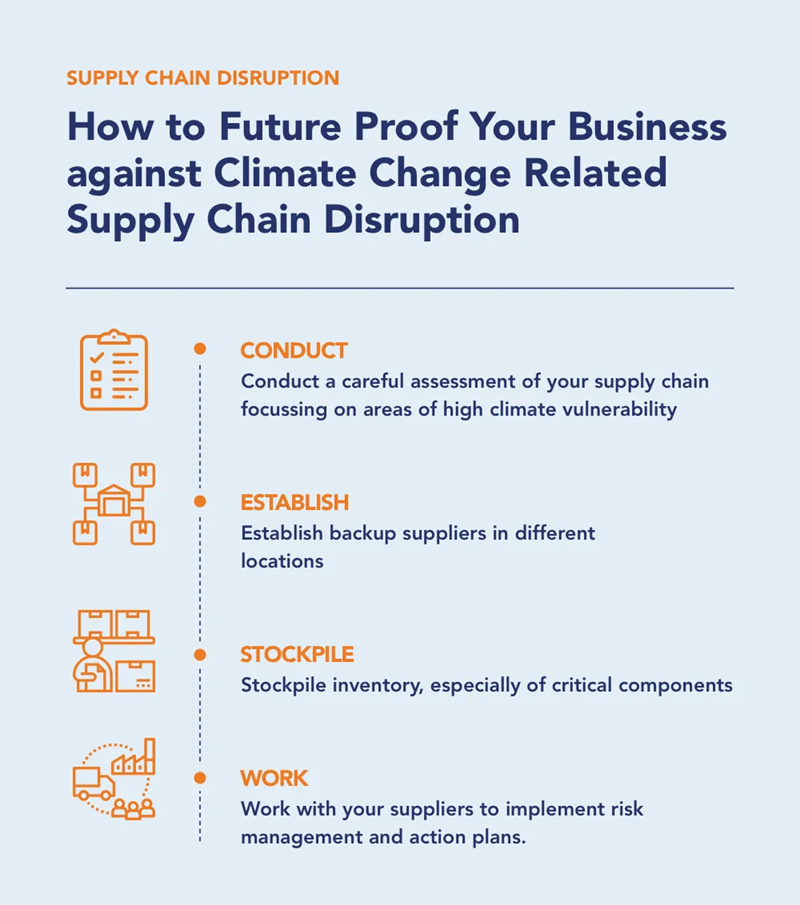FST BLOG
The Impact of Climate Change on Businesses and What You Can Do To Prepare
- 18 May 2020
- Environment
- Piers Moore-Ede

The COVID-19 pandemic has highlighted how events that are not directly linked to the economy can have a crushing effect on businesses around the world. Eventually, when much of the world reopens for business, the wheels of industry will start to turn once again and drive us inexorably forwards towards the next global crisis - and without action now, this time it will be even more difficult to resolve.
According to the New York Times, businesses will start to see the impact of climate change on their bottom lines within the next five years, with total losses estimated at one trillion dollars.
Wall Street has already built a metric called ‘climate resiliency’ into its calculations when evaluating companies. It considers a wide range of climate issues, from rising sea levels to record heat waves, and explores what businesses are doing to address the risks. But how could climate change affect your business model, and what steps can you take to prepare your business for the challenges ahead?
1. Extreme Weather Events
Probably the most obvious impact of climate change is the increase in extreme weather events. The latest data reveals a dramatic rise in the number of floods, droughts and hurricanes over the last 40 years, but particularly in the last five years. 2018 was a big year for natural disasters, with Aon’s Weather, Climate and Catastrophe Insight 2018 Annual Report assessing the economic cost at USD 225 billion. Making 2017 and 2018 the costliest back-to-back years for weather disasters ever.
In the UK, it was the big freeze known as the ‘Beast from the East’, mass flooding and storms that led to insurance losses running into the hundreds of millions. However, it’s the protection gap (the proportion of losses not covered by insurers) of 60%, that will be the biggest cause for concern for many businesses. Without adequate cover, firms that feel the force of extreme weather events could collapse, and even those with cover will see the cost of their premiums rise as payouts inevitably increase.
What can business owners do?
- Make sure you have comprehensive insurance in place that includes cover for property damage and third-party bodily injury
- Conduct a thorough risk analysis and stress test different scenarios
- Give employees weather safety training that includes shutting off the building’s electricity, gas and water
2. Supply Chain Disruption
Another way businesses of every shape and size are likely to be affected by climate change is in the disruption of their supply chains. Having an efficient supply chain plays a key part in the overall success of the business. When it’s disrupted, whether it’s due to an inability to source raw materials or a delay in sourcing information, people or resources, the impact can be so severe that it leads to the failure of the company.
As an example, with more than 14,500 firms reliant on Thai suppliers, severe flooding in Thailand in 2011 caused disruption for businesses around the world. Western Digital, a company with a third of the international hard drive market, lost nearly half of its shipments. Leading to a global shortage of hard drives, with NEC making 10,000 redundancies and HP losing USD2 billion.
What can business owners do?

Source: https://www.companydebt.com/
3. Regulatory Changes
New legislation will undoubtedly be introduced as governments strive to reach the targets they signed up to as part of the 2015 Paris Agreement. New regulations have already been introduced in the automotive industry, with heavy fines for manufacturers that fail to meet them. Other high polluting industries, such as aviation and sea-borne shipping, will soon follow suit, with new regulations reaching increasing businesses over time.
With that in mind, all companies must start to think about the steps they can take to reduce their carbon emissions. In order to protect themselves against future regulations, some larger companies have already implemented internal carbon pricing (ICP). ICP incorporates the costs associated with carbon production into future operational costs and investments. However, there are a number of steps businesses of every size should take.
What can business owners do?
- Calculate the current carbon footprint of your business
- Explore the strategies you can implement to reduce your emissions
- Consider adopting internal carbon pricing
- Conduct feasibility analysis around carbon abatement technologies (CATs)
4. Shifting Demand
A changing environment will inevitably bring shifts in demand. For example, as temperatures rise, we’ll see a fall in demand for winter goods such as heaters, while a growing risk of flooding will bring an increased demand for water pumps. Many consumers will also shift from fossil fuel-dependent products to products that run on renewables, and buying sustainable, environmentally friendly goods will become a priority.
However, it is not just producers of polluting products that will feel the pinch. There are entire industries that will suffer if climate change is allowed to continue unchecked. Acidified seawater will harm global fishing, depleted snow cover will damage the European ski industry and winemakers could have entire harvests wiped out by rising temperatures and rainfall.
What can business owners do?
- Assess the vulnerability of their products and services to fluctuating demand based on the way the climate is changing locally
- Explore strategies that will help to limit the disruption to your business
- Consider diversifying to products and services that will provide more stable revenue streams
Conclusion
Climate change is much more than just an environmental issue. It will have a profound impact on every part of our lives, including the businesses we run. Only by tackling climate change on a global and national level, planning ahead and adapting will businesses be able to succeed in this changing world.
Piers Moore-Ede is an award winning writer and journalist currently heading up the digital team at Company Debt.
